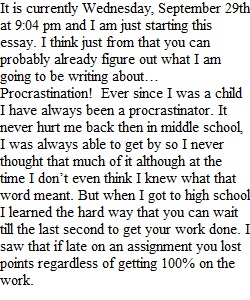


Q Self-Reflection Paper Topic: Learning and Unlearning Behavior https://youtu.be/F3aFCqnIhuo (Links to an external site.) Chapter 5 is all about learning behavior. Each and everyone one of us has acquired a number of behaviors over many, many years. And whether these behaviors are good, bad or extremely ugly, they were learned through one of the three learning theories we’ve been discussing (at least according to learning theorists). The great thing about learning is that if a behavior can be learned, odds are that it can be unlearned. In this reflection paper your goal is to: • o What is the behavior? Identify ONE BAD HABIT that you have LEARNED but would like to change (NOT a bad habit you have already extinguished. NOT a behavior that you would like to extinguish in someone else). Choose ONLY ONE bad habit and focus on that. Do NOT choose something more complex that could be considered a personality trait or an emotion--that would be difficult to explain using learning theory. Remember, Behaviorists focus on OBSERVABLE, MEASURABLE behavior. ? For example, don’t say “I’d like to change my anger,” or "shyness", or "my tendency to please others"--these are NOT good choices. These are emotions/personality traits that are not likley to be learned through behaviorist theories. ? BAD choices for this paper = anger, anxiety, shyness, rudeness, people pleasing etc. ? GOOD EXAMPLES for this paper= procrastination, nail biting, smoking, drinking, overeating, too much TV/videogames/social media, etc. These can ALL be easily measured so that you can Something that you can easily see if you begin doing more or less of this habit. Then briefly describe the behavior and how it has become problematic in your life. ? What learning theory applies? Identify which theory (classical conditioning, operant conditioning, or social-cognitive learning theory) best explains how you acquired the behavior and why? Be sure to use terminology that is appropriate to that learning theory. The point of your essay is to demonstrate your understanding of these theories and your ability to apply them accurately, so you MUST be detailed. ? How can you unlearn this behavior? Now that you have explained how you acquired this behavior, use learning theory to discuss how you can extinguish the behavior. Which learning theory (classical conditioning, operant conditioning, or social-cognitive learning theory) will you use to help unlearn the behavior and how? What is the specific plan? Again, be sure to use appropriate learning theory terminology. It is necessary to demonstrate an understanding of the material in Chapter 5, Module 3. ? Grammar, Spelling and Organization. This is a college level ESSAY and should be organized in essay format. An essay is NEVER one long paragraph. You should carefully spell check and grammar check your work. Try this: Read your essay OUT LOUD and see how it sounds. If there are sentences that make you pause, then they are not good sentences—fix them. Remember you may also utilize the writing center for assistance--they are excellent and can set up online appointments to help review your work. They can proofread a draft and offer suggestions ONLINE. The following grading rubric will be used, so make sure that you have accurately addressed each component. Remember, the point of the essay is to demonstrate an understanding of the theories presented in Chapter 5/Module 3 and your ability to accurately apply those theories: Topic Area Points ONE Problematic Bad/Habit Clearly Identified, Detailed & Measurable /3 Acquisition: Choose ONE theory (classical conditioning, operant conditioning OR social-learning theory) as the cause of your bad habit. Correctly explain how the behavior has caused the acquisition of your bad habit by using specific, detailed and correct terminology from the theory. /7 Extinction: Choose ONE theory (classical conditioning, operant conditioning OR social-learning theory) to plan for extinction of your bad habit. Correctly explain how you will apply the theory by using specific, detailed and correct terminology from the theory. /7 Overall quality: Clarity, organization, grammar, spelling and APA citations if applicable). /3 Other Guidelines: Papers MUST be submitted here. Emailed papers or attachments will NOT be accepted. You SHOULD type your essay directly into the assignment (you can exit and return as many times as you like until you hit the submit button). You can cut and paste from a word document BUT keep in mind that if you cut and paste IT MAY CHANGE the formatting of your work. If this happens you should fix the formatting to ensure proper essay format before submitting. The essay should be no more than 2 pages (approximately 500 words) in length, using 12 point font, double spaced (if you type directly into Canvas, it will double space for you). • When you mention a concept or theory in your paper, be sure to provide a definition/explanation from the textbook. • When you take a definition/explanation from the textbook, do not copy it word for word; instead, paraphrase in your own words and cite the textbook in APA style (Hockenbury and Hockenbury, 2016, pg #). BEWARE of PLAGARISM.
View Related Questions